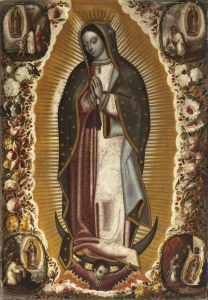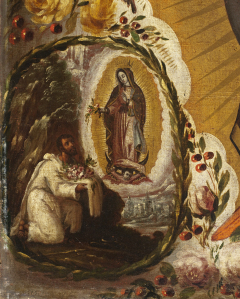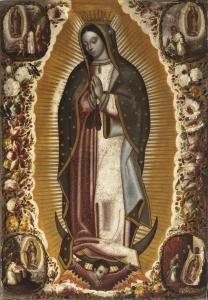At a recent workshop, a group of public school teachers asked me what the museum can do to help them obtain high-resolution images of works of art for use in the classroom. We just launched our new online Image Library and I think they’ll be pleased. We started with 2,000 high-resolution images of works of art that we believe to be in the public domain, to download and use for free. Over time, we look forward to continuing to provide even more public domain images of works in our encyclopedic collection.
Digging around, I found a few highlights.

Manuel de Arellano, Virgen de Guadalupe, 1691, oil on canvas, Purchased with funds provided by the Bernard and Edith Lewin Collection of Mexican Art Deaccession Fund, M.2009.61
This Virgin of Guadalupe was a big hit when we announced its acquisition on our blog back in 2009. Using the zoomify feature, or by exploring the secondary images included in the entry, you can hone in on the amazing vignettes in the corners—at the lower left, for example, the Virgin appears to Juan Diego and fills his cloak with flowers.

detail, Manuel de Arellano, Virgen de Guadalupe, 1691, oil on canvas, Purchased with funds provided by the Bernard and Edith Lewin Collection of Mexican Art Deaccession Fund, M.2009.61
Scoot over to the lower right corner and you can see the next chapter of the story.
This sixteenth-century Dutch still life includes tulips, irises, roses, carnations, daffodils, and more.

Ambrosius Bosschaert, Bouquet of Flowers on a Ledge, 1619-1620, oil on copper, Gift of Mr. and Mrs. Edward W. Carter
Lest we get caught up in all of that pictorial perfection, the artist also includes some reminders of real life. Zooming in reveals a bug perched on that luscious white bloom at the left, and a nibbled leaf just below. At the foot of the vase, just to the left, there’s a bee. My colleague Mary Lenihan explained to me that the bugs are about decay—a dose of realism and a reminder of mortality.

detail, Ambrosius Bosschaert, Bouquet of Flowers on a Ledge, 1619-1620, oil on copper, Gift of Mr. and Mrs. Edward W. Carter
The Image Library allows visitors to explore works of art that are not currently on public view. We constantly rotate works of art from our encyclopedic collection, and at any given time, great works of art are in storage or in our conservation labs.

Anonymous, Shinto Sculpture in the Shape of a Seated Fox, Japan, Momoyama period, 1573-1615, wood with white pigment and sumi ink, Gift of the 1993 Collectors Committee, AC1993.40.1
I love this Shinto fox from the sixteenth century with his expressive face and intelligent eyes. He used to guard a shrine. Apparently, he was thought to have special powers, including the ability to read the secret thoughts of humans. There are also some excellent nineteenth-century Japanese scrolls represented in the Image Library. (One of my favorites depicts two boys in the midst of a prank—grinning so wide, their tongues appear to be hanging out of their mouths.) These works of art are light-sensitive and rotate constantly--so the Image Library is a nice complement to the in-gallery presentation, allowing scholars to take a close look at works that may only occasionally be on display.
Giving away high-resolution images is a new undertaking for the museum, driven by our desire to open up access to great works of art at LACMA. Please comment and tell us how you are using these images. We’re curious to hear what you come up with.



